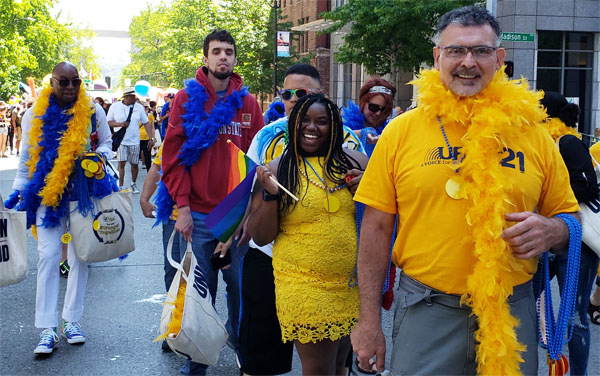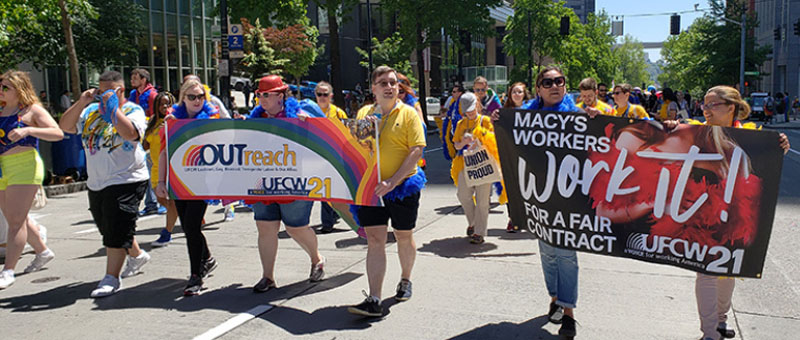OPINION
We won a great contract at Macy’s–with style
By NICHOLE BOOKER and CURTISY BRYANT
(April 4, 2019) — When department-store workers fight, we do it fashionably. Have you ever seen a union contract campaign that featured makeovers and feather boas? Read on.
We had worked hard for Macy’s, and frankly we were fed up. Like a lot of working people out there, we work for a company that’s doing fine, yet they want to cut staff and expect us to pick up the slack.
The slack, if there ever was any, was picked up a long time ago. If you’re like us—and like most people in America—you’re struggling to make ends meet even though you have a job.
The good news is, unlike most workers in retail department stores, we have a union. Here in northwest Washington state, 850 employees at six Macy’s stores are members of Food and Commercial Workers Local 21. Nationwide we’re joined by UFCW members at 27 other Macy’s stores.
In our latest contract campaign we were able to fend off Macy’s demands and make significant gains… and we had fun doing it. A record number of our co-workers got involved, helped dream up creative tactics, and turned up the heat until Macy’s gave in.
Last spring, our contract was getting ready to expire. Our co-workers wanted wage increases and to solve scheduling problems. For many of us it was difficult to get enough work hours in a week, and the company kept changing our schedules.
BIGGEST C.A.T. EVER
We knew management would resist making improvements, because the market for our stores is challenging. We work retail every day, so you don’t need to tell us that. What we did not know was that Macy’s would push so hard for cuts to our existing contract.
For example, we have two categories of jobs—the sales staff and the support workers who place the merchandise. Macy’s wanted to turn everyone into a generalist doing all the functions in the store, but the company wasn’t willing to pay everyone the higher wage.
Sick leave was another big sticking point. Our union had helped to pass a new state law requiring employers to offer paid sick days. But instead of adding sick days to comply with the new law, management wanted to count the personal days and vacation time that we already had in our contract. We felt we had earned that time off, and sick leave should be something separate.
Incensed at the company’s demands, we built the biggest Contract Action Team we’ve ever had. Longtime union activists did a great job recruiting newer co-workers. We started with a bargaining survey and gradually escalated the pressure on Macy’s.
PRO-UNION MAKEOVER
To ensure wide participation, we chose a first action that wasn’t too hard: wearing buttons. We designed the buttons to look similar to Macy’s ads, but with union members as the models in the photographs.
Since we were coordinating our campaign with Macy’s workers at UFCW Local 400 in the D.C. area, both unions used the same button theme. We even wore some of each other’s buttons to show our unity.
We also looked for ways to show Macy’s that customers would take our side.
Unions and community groups helped by participating in “makeover” days. Supporters would come into the store, wearing the T-shirts of their unions and organizations, and sign up for services such as having mascara applied.
Before leaving, each customer would visit the store manager’s office to deliver a coupon with a message of support for our fight.
 For Seattle’s famous Pride Parade in Capitol Hill, we wrapped a vehicle bumper-to-bumper with our UFCW 21 logo and mission. Macy’s had its own float right behind ours, so the company got a prime view of us taking our campaign to the public.
For Seattle’s famous Pride Parade in Capitol Hill, we wrapped a vehicle bumper-to-bumper with our UFCW 21 logo and mission. Macy’s had its own float right behind ours, so the company got a prime view of us taking our campaign to the public.
FEATHERS EVERYWHERE
As the campaign got hotter, the Contract Action Team was meeting in person every few weeks to hear bargaining updates and plan upcoming actions. We used every means to keep our co-workers up to date: newsletters, emails, mass text messages, and lots of face-to-face conversations.
A member-run Facebook group grew into a lively campaign hub. Out of 850 workers, about 300 were active in this group, sharing action photos and discussing store issues. There were new posts nearly every day.
When the Macy’s CEO came to visit one of our stores, we tried to set up a meeting with him. He refused to talk, and tried to avoid us. The bargaining team ended up pursuing him through the store. That experience fired members up.
Next we held “Work It” fashion shows outside our stores. At the entrance to the South Center Mall we set up a red carpet, balloons, and a big speaker. We invited community partners too. Union members and supporters strutted and flounced down the runway while the emcee described what they had chosen to wear and why.
Macy’s workers had a great time. So did customers, who stopped to watch and clap. We handed out balloons and feather boas in our union colors, yellow and blue. Many customers took them, especially those with kids. Soon the stores were full of feathers and managers were coming out to gripe.
We hoped those managers were thinking, “If they’re doing this now, what are they going to do next?”
EMPTY STORES
As the summer dragged on into August, Macy’s was still standing firm. We held informational picketing in front of our stores to talk to customers. In September we voted overwhelmingly to reject the company’s contract proposal.
Despite our vote, Macy’s stuck to its guns with proposals that would have kept wages far too low, left our hours and scheduling messed up, and forced us to give up our vacation time in exchange for sick days.

So in October we held another informational picket. This time, even workers who were scheduled to work used their personal days to come outside and join the picketing.
The stores were nearly deserted. It wasn’t a strike, but it gave Macy’s a taste of what a strike might look like. Finally the company got the message.
That’s when Macy’s started to do what you’re supposed to do in negotiations—actually negotiate. The company began to withdraw its really bad proposals and we were able to get down to business. In fact, we won some big advances.
STEPS FORWARD
In the final deal, we protected our vacation days and added an additional personal day, something Macy’s workers haven’t been able to win anywhere else in the country.
We won new scheduling options that will allow people to get more hours. We also changed the wage progression so that it’s based on years worked, instead of hours worked—removing an obstacle that had made it harder for part-time workers to get a raise.
The only place where we allowed the company to combine the sales and support functions into generalist jobs is at the Macy’s Backstage stores, which employ very few workers—and even there, all those workers will get the higher wage rate. They will also have the option to move into a regular store if they don’t want to do both job functions.
We feel this contract campaign was a success story. It worked because we stuck together and kept a clear-eyed focus on the issues that were most important—and because so many members worked to get their co-workers involved in the fight.

 Nichole Booker is a sales associate at the SeaTac Macy’s. Curtisy Bryant is a cosmetics associate at the SouthCenter Macy’s. Both are members of UFCW 21 and were members of the Macy’s contract bargaining team in 2018. This column, which first appeared in LaborNotes, is crossposted at The Stand with the authors’ permission.
Nichole Booker is a sales associate at the SeaTac Macy’s. Curtisy Bryant is a cosmetics associate at the SouthCenter Macy’s. Both are members of UFCW 21 and were members of the Macy’s contract bargaining team in 2018. This column, which first appeared in LaborNotes, is crossposted at The Stand with the authors’ permission.






